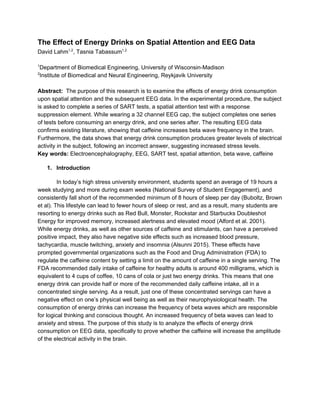
The Effect of Energy Drinks on Spatial Attention and EEG Data
- 9. consumption of caffeine for at least 12 hours before. Because the procedure was completed within the hour on a single day, differences in external factors were accounted that could have affected the results, such as fatigue and consumption of other food and drink. We were able to accept our hypothesis. The results were comparable to the results of other studies in terms of the effects of the ingredients commonly found in energy drinks in terms of beta brain wave activity. 6. Future Work In the future, it would be best to create a more formalized version of this study. In the course of the experimental procedure, we realized that it would have been best to complete the normal SART test and post energy drink SART test on separate days, or at least with a greater time interval in between, so that the subject does not experience any fatigue that will affect the results. Along with this, we should ensure that the subject has not become accustomed to the SART tests to the point of gaining proficiency. Another important change to be made to the experiment is the number of subjects. Three subjects is not a sufficient number to produce experimentally sound results, so any future experiments should include much more than three subjects. Acknowledgements: We would like to thank Kyle Edmunds and Paolo Gargiulo for their technical and experimental advice along the way. Along with this, we would like to thank Berglind Fredriksdottir for volunteering as an experimental subject. Conflict of Interest: The authors declare no potential conflicts of interest with respect to the research, authorship, and/or publication of this article. References 1. Alford C, Cox H, Wescott R. The effects of Red Bull Energy Drink on human performance and mood. Amino Acids. 2001;21(2):139150. 2. Al Sunni A. Energy Drink Consumption: Beneficial and Adverse Health Effects. International Journal of Health Sciences. 2015;9(4):468474. 3. Buboltz W, Brown F, Soper B. Sleep Habits and Patterns of College Students: A Preliminary Study. Journal of American College Health. 2001;50(3):131135. 4. Giles G, Mahoney C, Brunyé T, Gardony A, Taylor H, Kanarek R. Differential cognitive effects of energy drink ingredients: Caffeine, taurine, and glucose. Pharmacology Biochemistry and Behavior. 2012;102(4):569577. 5. Grant D, Tang B, Kalow W. Variability in caffeine metabolism. Clin Pharmacol Ther. 1983;33(5):591602.
- 10. 6. Higgins J, Tuttle T, Higgins C. Energy Beverages: Content and Safety. Mayo Clinic Proceedings. 2010;85(11):10331041. 7. Kinzie J. How Much Time College Students Spend Studying Varies by Major and Corresponds to Faculty Expectations. National Survey of Student Engagement. 2011;. 8. Vaney N, Dixit A, Goyal A, Thawani R. Effect of caffeine on information processing: Evidence from stroop task. Indian J Psychol Med. 2012;34(3):218. 9. Whirley B. Taurine Trials in Animal Models Offer no Support for Anxiolytic, Antidepressant or Stimulant Effects. Israel Journal of Psychiatry. 2008;45(1):811.